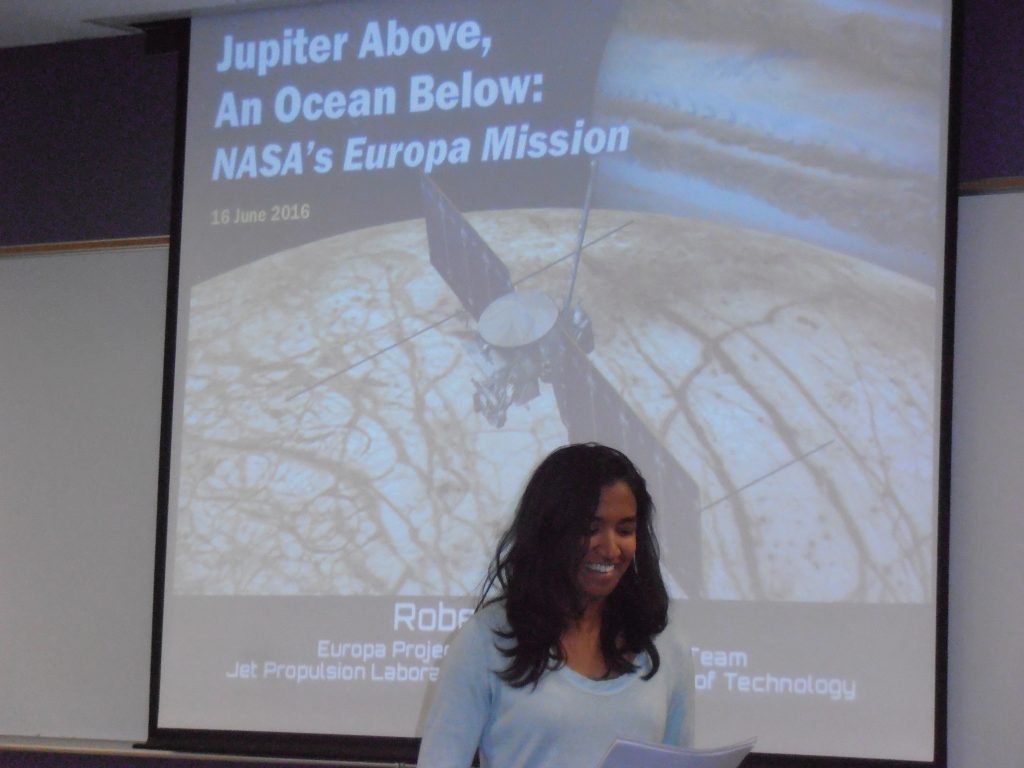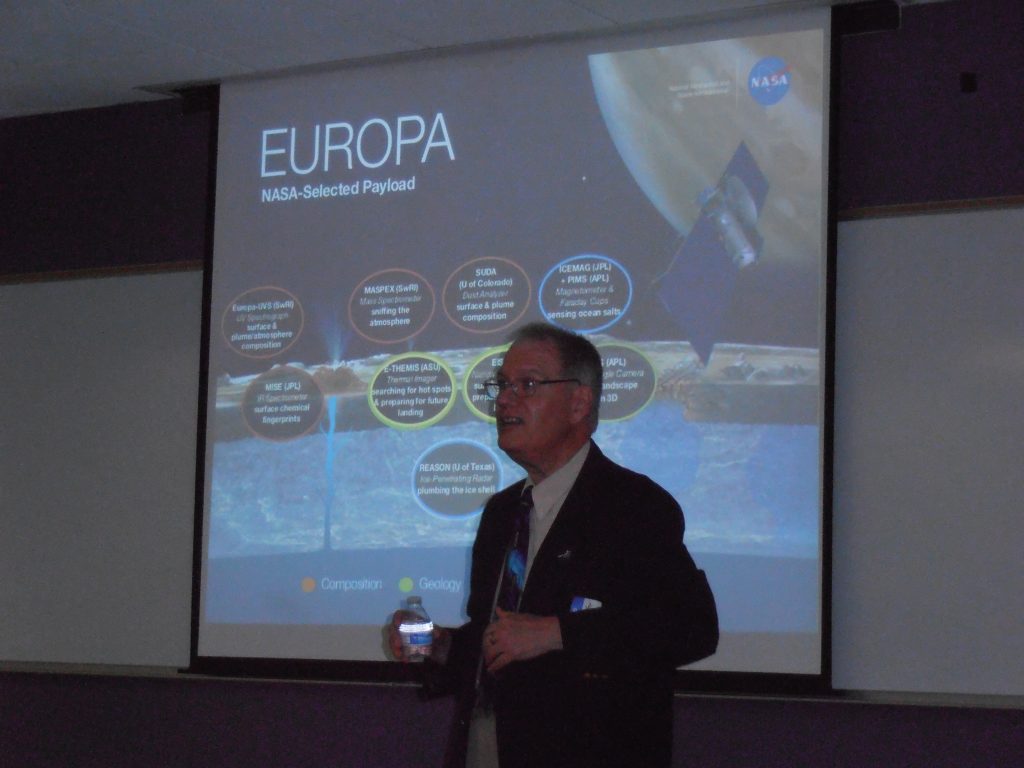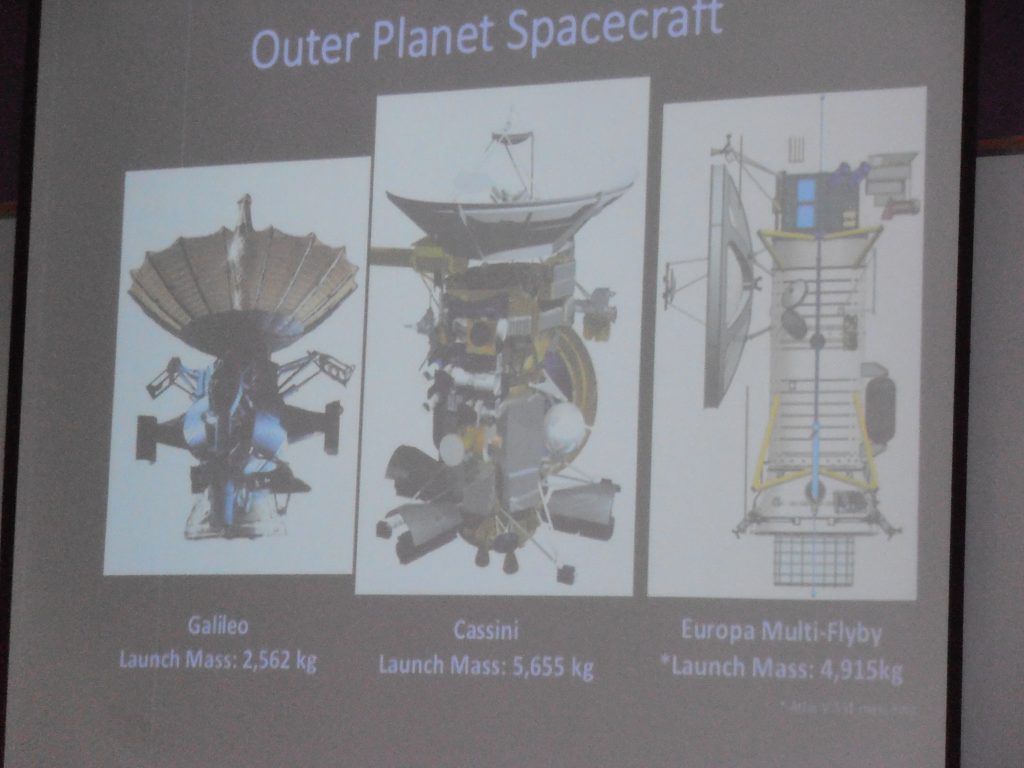NASA / JPL “EUROPA MISSION” TALK AT IEEE BUENAVENTURA JUNE 16,2016
| July 25, 2016 | Posted by Frank Gomez under COMSOC, CS, EDCAS, General, MTT/APS, PES |
Comments off
|
On Thursday, June 16, 2016, a talk on the NASA EUROPA mission was held at California Lutheran University, Thousand Oaks, CA sponsored by the IEEE Buenaventura Section. The title was intriguing, “Jupiter Above, the Oceans Below, the Search for Life on Europa”. The speaker was Robert Gounley from NASA-JPL.
The title of the talk contains the clue and the rational for this proposed probe. An earlier mission, Galileo spacecraft (1995 to 2001) obtained a near-infrared spectrometer that detected water vapor lines on Europa. This led to the collection of many images of Europa. These showed cracks in the ice; often with very structured patterns and symmetries. Others showed ridges where the cracks in the ice crossed. An image from the Hubble telescope in 2013 showed active geysers erupting on the south pole of Europa. Our speaker showed a representative collection of Europa visible imagery. Europa has a diameter of about 2000miles, a bit less that the diameter of the Earth’s moon. This gives some size showed cracks in the ice perspective on the cracks that showed up on images of Europa.
An analysis of this data led to the postulate that there was tidal flexing and tidal heating below the surface. Plate tectonics motion, indicated in the photographed cracks, pointed to a dynamic crust, similar to Earth. Some broad imagery bands showed reddish features, which implied that minerals were moving up from the crust through the ice / water cover to the surface. This water / ice cover could be up to 100 km thick. Note that the temperatures at the equator are estimated at less than -260F; at the South Pole the estimates are less than -370F.
It is this water / ice cover of Europa that is driving the planned Europa mission. Is there “Life” somewhere else in the universe; not just the “Life” we experience first-hand on earth. Europa becomes a prime candidate for such a search. According to our speaker, the efforts of this Europa mission, and the instruments that are being developed to be placed on board, will be looking for evidence of such “Life”. These are (1) water, (2) some essential elements, (3) chemical energy as evidenced by some known and familiar chemical reactions, and (4) some stability in the atmosphere and crust of this million year old moon. We can expect to obtain important information from the infrared imaging spectrometer onboard to bound these questions. NASA /JPL has been accumulating data on spectra and hyperspectral remote sources on the AVIRIS (visible and infrared) program for many years.
The planning for this mission is underway now. A possible launch date would be 2020 to 2022, with a six year space voyage to get to the vicinity of this moon. Long loop fly-by orbits about Europa would be executed. This is necessary to limit Europa spacecraft radiation damage. Flying near Jupiter will “suck up” particles from its radiation belt. The orbit will be near Europa for a 5.5 hours period during each two week orbit. Data will be sent back to Earth at about 1,000 bits per second. When you are power limited, and your signal has to travel a considerable distance back to the Earth base station, every bit received with a passable S/N ratio is special.
The Q & A brought out some interesting thoughts from the audience. If a spacecraft has to travel through the intense and variable electromagnetic field near Jupiter, can an onboard electric motor be developed to use this EMF source for spacecraft power? When the Europa probe is at the minimum fuel point, it will be directed towards Jupiter. Burning up on reentry will satisfy a requirement levied on the NASA Planetary Protection engineers. So, this Europa mission will not contaminate any future mission to Europa by leaving behind evidence of Earth human life circa 2020. Our audience will have to figure out if any human or Earth micro- bioorganic material could possibly survive in the Europa or the Jupiter atmosphere, as we know these today. That would be a true “Life” question.
While awaiting further activity on the Europa mission, we will be receiving photos and information on the NASA / JPL Jupiter probe, including imagery of the four Galilean moons of Jupiter, which arrived on schedule about two weeks after this talk, on July4, 2016.

The IEEE Buenaventura IEEE Team: Ms Sarfraz, and Ms Natalie Gosset, IEEE BV Chair, all operating under the Eye of a Distinguished IEEE Southern Section official. Thank you for a good evening’s talk
We thank our speaker, Robert Gounley for an informative talk, and the IEEE Buenaventura Section for hosting this event and inviting visitors from other IEEE Sections to attend.



